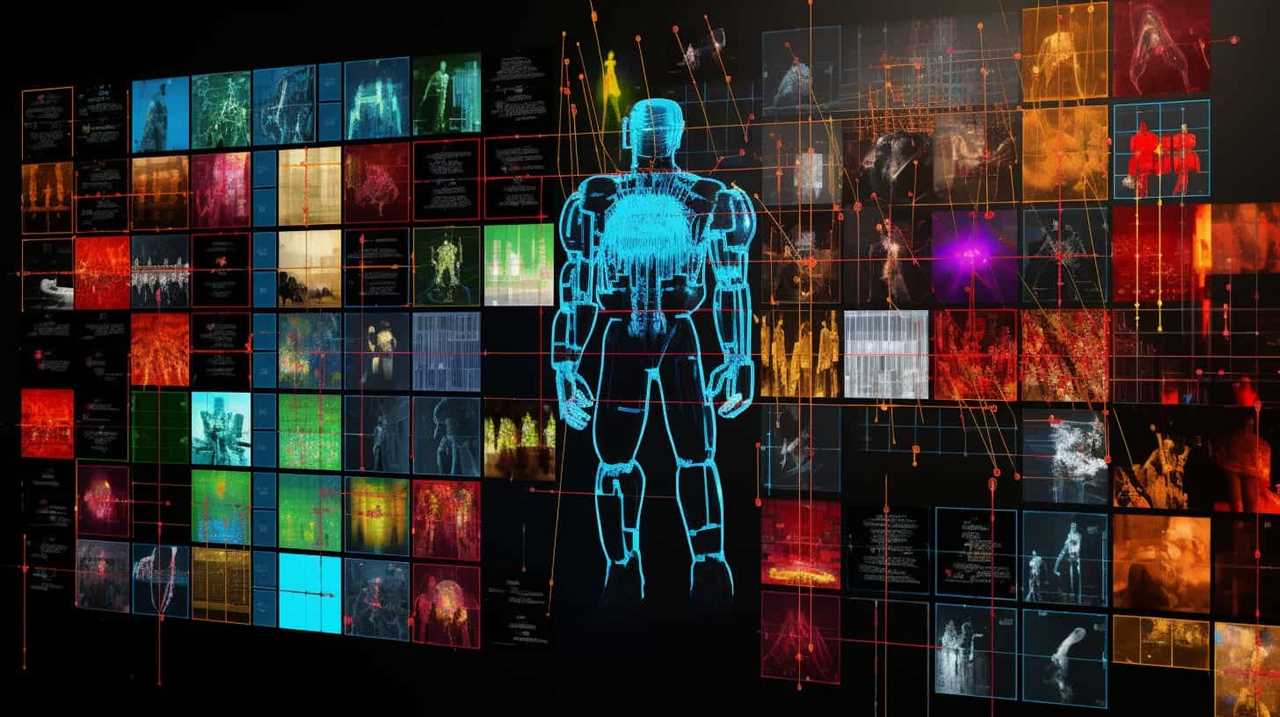We have all seen the incredible progress made in the field of artificial intelligence (AI). Were you aware that deep learning techniques have been instrumental in these advancements?
In this guide, we will explore the intricacies of mastering AI development through deep learning. From understanding neural networks to implementing convolutional and recurrent neural networks, we’ll delve into enhancing deep learning models with generative adversarial networks and applying transfer learning techniques.
Join us on this innovative journey to unlock the full potential of AI.
Key Takeaways
- Neural networks mimic the structure and functionality of the human brain.
- Data augmentation techniques expand the dataset and reduce overfitting.
- RNNs excel at handling sequential data due to their ability to retain information.
- Transfer learning leverages pre-trained networks to improve model performance.

Understanding Neural Networks
To begin our exploration of deep learning techniques, let’s delve into the concept of neural networks.
Neural networks are a fundamental component of deep learning, mimicking the structure and functionality of the human brain. The neural network architecture consists of interconnected layers of artificial neurons, each responsible for processing and transmitting information. These layers are organized into an input layer, hidden layers, and an output layer.
The neural network learns by adjusting the weights and biases of the connections between neurons during a process called training. Training algorithms, such as backpropagation, play a crucial role in optimizing the network’s performance by minimizing the prediction error. These algorithms iteratively update the network’s parameters based on the difference between predicted and actual outputs.

Implementing Convolutional Neural Networks
Now, let’s transition from understanding neural networks to implementing convolutional neural networks (CNNs) in our exploration of deep learning techniques. When it comes to implementing CNNs, there are two important aspects to consider: data augmentation techniques and optimizing hyperparameters.
Data augmentation techniques play a crucial role in training CNNs by expanding the dataset and reducing overfitting. These techniques involve applying transformations such as rotation, scaling, and flipping to the original images, creating new variations that improve the model’s ability to generalize.
On the other hand, optimizing hyperparameters involves finding the best combination of values for parameters like learning rate, batch size, and regularization strength. This process is typically done through techniques like grid search or random search, which systematically explore the hyperparameter space to identify the optimal values.
By leveraging data augmentation techniques and optimizing hyperparameters, we can enhance the performance and accuracy of our CNN models, enabling us to tackle complex deep learning tasks with innovation and precision.
| Data Augmentation Techniques | Optimizing Hyperparameters |
|---|---|
| Rotation | Learning Rate |
| Scaling | Batch Size |
| Flipping | Regularization Strength |

Exploring Recurrent Neural Networks
First, let’s delve into the capabilities of recurrent neural networks (RNNs) and their applications in the field of deep learning. RNNs are a type of neural network that excel at handling sequential data due to their ability to retain information from previous steps in the sequence.
One popular variant of RNNs is the Long Short Term Memory (LSTM) network. LSTMs address the vanishing gradient problem by incorporating a memory cell that can store information over long periods of time.
Another variant is the Gated Recurrent Unit (GRU), which simplifies the architecture of LSTMs by combining the forget and input gates into a single update gate.
Both LSTM and GRU have been widely used in tasks such as speech recognition, language translation, and sentiment analysis, showcasing the power of recurrent neural networks in capturing temporal dependencies in data.

Enhancing Deep Learning Models With Generative Adversarial Networks
Moving forward, let’s explore how we can enhance deep learning models with the use of Generative Adversarial Networks (GANs). GANs offer a powerful technique for generating synthetic data, which can greatly benefit deep learning models.
Here’s how GANs can improve model robustness:
- Data Augmentation: GANs can generate synthetic data that closely resembles the real data, increasing the diversity of the training set and reducing overfitting.
- Addressing Imbalanced Data: GANs can generate synthetic samples for minority classes, helping to balance the dataset and improve model performance on underrepresented classes.
- Adversarial Training: By training a discriminator to distinguish between real and synthetic data, GANs can push the generator to produce more realistic samples, leading to better generalization.
- Transfer Learning: GANs can generate synthetic data in a source domain, which can then be used to train a deep learning model for a related target domain, improving model performance in the target domain.

Applying Transfer Learning Techniques in Deep Learning
To further explore the benefits of enhancing deep learning models, let’s delve into the application of transfer learning techniques in deep learning.
Transfer learning involves leveraging pre-trained networks to improve the performance of new models. Instead of training a deep learning model from scratch, transfer learning allows us to utilize the knowledge gained from pre-trained models that have been trained on large datasets. This approach saves computational resources and reduces training time.
One common transfer learning technique is fine-tuning, where we take a pre-trained model and adjust its parameters to fit our specific task. By fine-tuning models, we can benefit from the learned representations of the pre-trained network and build models that perform well even with limited training data.
Transfer learning techniques in deep learning provide a powerful way to accelerate model development and achieve state-of-the-art results in various domains.

Frequently Asked Questions
How Can We Handle Overfitting in Deep Learning Models?
To handle overfitting in deep learning models, we can use regularization techniques such as L1 and L2 regularization. Additionally, cross validation can help us assess the model’s performance on unseen data and prevent overfitting.
What Are Some Common Challenges Faced When Training Deep Learning Models?
When training deep learning models, we face common challenges such as overfitting, lack of training data, and computational resources. To overcome these, we employ techniques like data augmentation and regularization to enhance model performance and generalization.
Can Deep Learning Models Be Used for Unsupervised Learning Tasks?
Yes, deep learning models can be used for unsupervised learning tasks. They have shown promising results in various applications such as clustering, dimensionality reduction, and generative modeling, improving overall model performance.
What Are the Limitations of Convolutional Neural Networks When Applied to Image Classification?
When it comes to image classification, convolutional neural networks have limitations and drawbacks. They may struggle with recognizing objects that are partially occluded or have complex backgrounds.
Are There Any Ethical Considerations to Take Into Account When Using Generative Adversarial Networks (Gans) in Deep Learning Applications?
There are ethical considerations to take into account when using GANs in deep learning applications. One such consideration is the potential misuse of generated data, which can raise concerns about data privacy and consent.

Conclusion
In conclusion, after delving into the intricacies of deep learning techniques, we’ve mastered the art of AI development.
Neural networks, whether convolutional or recurrent, have been dissected and implemented with finesse.
Our exploration of generative adversarial networks has elevated our deep learning models to new heights.
And finally, we’ve harnessed the power of transfer learning techniques to enhance our AI creations.
We can confidently say that we’re now the maestros of AI development, ready to conquer new frontiers in this ever-evolving field.









